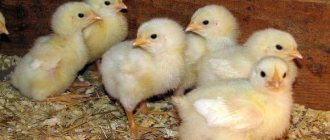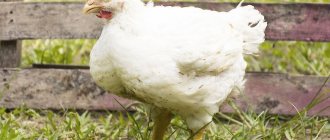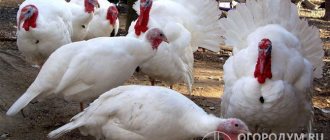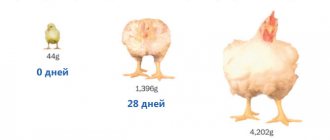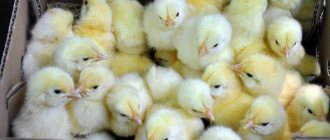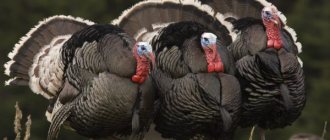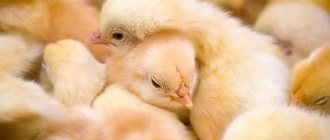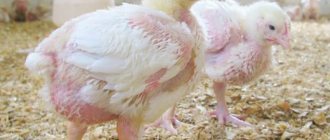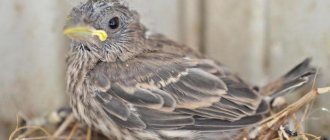To raise a viable population of chickens at home, it is very important to know what to feed chickens from the first days of life. Regardless of whether the chicks were hatched by a hen or they were born in an incubator, babies first of all require careful care and a balanced diet. The rapid growth and good development of poultry is ensured by a complete, environmentally friendly diet, including proteins, fats, carbohydrates, vitamins (A, C, E, D, group B) and minerals (calcium, phosphorus).
The chicks’ body is very susceptible to the slightest disturbances in diet, food composition and quality
The first days of life of chickens: caring for young animals
The development of avian offspring and its health are influenced by many indicators.
"Feathered" must:
- Stand firmly on your feet;
- Have a toned tummy, a clean umbilical cord;
- Be neat, lively and active;
- Have soft plumage;
- React to external stimuli;
- Take food and water independently;
- Its wings should fit snugly to the body.
Day-old chicks are very vulnerable to disease and may experience discomfort from food that is not selected in the best way. Therefore, caring for them involves maintaining and creating:
- Lighting mode;
- Ventilation without drafts;
- Required temperature indicators;
- Balanced diet and adherence to feeding regimen;
- Optimal humidity in the poultry house.
Before moving the “kids” into the home, it is necessary to clean it, disinfect it, and cover the floor with dry, loose bedding material. Also, raising chickens involves checking the premises for protection from rats and mice, and providing everything necessary to support the life of the young. Such equipment consists not only of lamps and heating devices, but also of safe drinkers and feeders. It is recommended to accommodate 12 pets per meter of area.
Summarizing
If you have sufficient desire and basic knowledge, you can even at home provide the necessary care for day-old chicks, as well as provide them with quality feeding. If you do everything correctly, very soon you can grow beautiful and healthy chickens and roosters from small yellow lumps, which means that there will always be fresh, tasty, and most importantly, healthy meat on the table. Bird breeds do not matter in this case. In general, in order to grow each of them and feed them correctly, you need to adhere to similar rules.
Lighting and air temperature when raising chickens
During the first weeks of life, most chicks experience discomfort from hypothermia or high temperatures. After all, until the age of one month, the body of “babies” cannot effectively adapt to changes in the external environment in the shortest possible time. Therefore, the poultry farmer is obliged to monitor humidity and temperature indicators. In a cool room, you need to install additional heating devices, and the hot room should be constantly ventilated. Therefore, the conditions for raising chickens must necessarily include careful control over the temperature in the chicken coop:
- For the first 24 hours, the bird's offspring must exist in the same conditions as they had in the incubator, at a temperature of 35 degrees (not lower);
- Then this indicator is systematically reduced to 30-32 degrees - in the first seven days from the moment small pets are born;
- From the 2nd week, temperature marks gradually continue to decrease so that by the age of one month the bird can live calmly at a temperature of 21 degrees;
Important: young animals need heating not only during the day, but also at night, as well as on cloudy days and during cold seasons.
Provide round-the-clock lighting for the chicken coop (especially in winter) using artificial incandescent lamps.
- The first few days the lamps are on constantly and do not turn off. This makes the chicks move more actively, grow and feed.
- Next, the lights are turned off for 15 minutes, then 30, accustoming the “birds” to the dark.
- When the young animals turn 4 months old, daylight hours are shortened to ten hours.
The light is set at a height of 45-50 cm, and the microclimate is controlled by installing a thermometer. If the inhabitants of the poultry house are crowded under the lamp or pressed against each other, they are obviously freezing. And the heat can make their wings and feathers ruffle and move little.
Preparing the poultry house
The main requirements for the room in which day-old chicks will be raised are:
- dryness,
- purity,
- correct and stable temperature conditions,
- well-organized lighting,
- possibility of ventilation.
Before introducing birds, you should clean the area of the poultry house, disinfect the drinking bowl, feeders and the entire room using special means.
To get rid of the smell of potent drugs, it is important to thoroughly ventilate the poultry house after treatment. You also need to make sure that the walls, floor and ceiling in the room are dry, and then whitewash them in several layers.
Broiler chickens are poorly oriented in a dark space, so they should be kept in a sufficiently lit room. The light must be turned on constantly for 20 hours a day. Accustoming young animals to darkness should occur gradually (it is necessary to turn off the lamps for a quarter of an hour, then turn them on, and after some time turn them off for a longer time). This way the birds will get used to the darkness and will not experience panic.
Preparing to keep chickens
In boxes
In the first days of life, chickens live in warm and dry boxes made of wood or cardboard, which must be disinfected and non-slip material placed on the bottom. The humidity of the environment is maintained within 60-70%.
On bedding
The maintenance of future chickens is seriously affected by permanent deep litter, which releases a lot of thermal energy. Such warm material protects the paws of young animals from cold temperatures, having a positive effect on the health of pets. With constant decomposition occurring in the material through the action of bacteria, young chickens have biologically active substances as an auxiliary source. For bedding it is better to use:
- Sawdust;
- Straw chaff;
- Peat;
- Wood shavings.
In cells
- They should be clean and dry.
- Supported:
- Correct ventilation and lighting;
- Required humidity and temperature conditions.
Litter selection
Litter is an essential element of the poultry house. Properly selected materials will ensure good thermal insulation in the room where the birds will be kept and protect the livestock from encountering dangerous microorganisms living in chicken feces.
To ensure sufficient looseness and dryness of the litter, it must consist of several layers. The material you can use is:
- hay,
- sawdust,
- wood shavings,
- sunflower seed husks,
- dry leaves.
Regardless of what material is chosen as bedding, the following requirements will be imposed on it:
- There should not be a drop of moisture in small parts of the bulk material (in order to eliminate the consequences of accidental getting wet, for example, due to heavy rain, it is necessary to dry the litter by first laying it out evenly on a flat surface).
- The material must have high absorbent characteristics.
- The embankment should have a crushed structure - all large particles should be immediately removed from the flooring.
- Mold, even in minimal quantities, is unacceptable.
The most affordable bedding option is layers of sawdust or dry grass. Laying the material should take place in several stages: lay the first thin layer - compact it well, lay the second - compact it again until the total thickness reaches 1 cm (for summer) or 2 cm (for winter).
It is also undesirable to make a thick layer: you need good air permeability so that a lot of chicken droppings do not accumulate in the material, which is toxic and very harmful to the chicks. The same litter cannot be used for a long time: it must be carefully renewed every few days.
Features of feeding chickens
The key to the subsequent development and good growth of future chickens is a balanced and nutritious diet, which should be selected according to the needs and age of the “kids”. Feeding of young animals after birth is carried out as quickly as possible. The sooner you offer chickens food, the sooner they will acclimatize and get used to new conditions. This will take about a day, during which the pets must have water. Day-old chicks are given a chicken egg for three or four days in a row. It should be hard-boiled and finely chopped. Next, other healthy foods are gradually introduced into the diet.
- The first addition is boiled millet, which is first mixed with an egg. Then the chickens are fed millet alone;
- Then crushed corn and shredded wheat are added to the porridge-like feed. They are easily digested, unlike barley and oats. Their seeds have a rough shell and can cause gastrointestinal irritation (diarrhea in “babies”). These grains can only be used as bird food when they are one month old or later;
- It is necessary to fill the feeders with greens in the first days. This includes finely chopped and scalded nettles, alfalfa, clover, green onions, finely chopped carrots;
- Fermented milk products - buttermilk, low-fat cottage cheese, milk powder, whey, yogurt. They are mixed into grain mixtures and wet food;
- On day 4-5, dishes with shells, fine gravel, pebbles, and crushed chalk are placed in the house;
- Fish or meat and bone meal is mixed into the food (earthworms or finely chopped meat waste can serve as a substitute). Protein in the feed is very important for birds;
- Add wood ash;
- From the tenth day you can eat zucchini, boiled potatoes, and pumpkin.
For the first ten days, young animals are fed at intervals of two hours, then at intervals of 4 hours, and then the interval between meals is reduced to six hours. Raised chickens eat only in the morning and in the evening. Clean and fresh water at room temperature should be placed in the poultry house every day and changed twice a day.
It is necessary to regularly wash the chicken coop, disinfect it, and remove old litter.
Useful tips
In order for the livestock to grow healthy, you need to pay attention to how to care for chickens in the first days of life.
If the young animal falls ill immediately after birth, you need to consult a veterinarian. In this case, prescribed drugs and medicines are given. For small individuals, it is undesirable to use any medicine due to unstable immunity and young age, but if the disease has attacked the entire chicken coop, the individuals should be treated by drinking medications or drugs in a small dosage, which will be prescribed by a specialist. The dosage should be selected only by a veterinarian after an in-person examination of the bird, depending on the stage of the disease and the cause of the disease.
With an intensive feeding method, when feathers first appear, you need to make sure that food does not stick to them. Also, if food sticks to the paws, corns form and the birds die because the paws cannot move due to the deposits. With this method, it would also be useful to have a veterinary consultation and certain medications to improve nutrition and immunity. At the first symptoms of the disease, the bird is given medications prescribed by a veterinarian. Supplements and vitamins will not be superfluous; you can take liquid supplements.
Raising pets under a hen
A proven and ancient technique is to raise chickens under a hen. For this role, they choose an experienced chicken with a well-developed maternal instinct.
Check using a simple method. When the black whooping bird sits in the nest closer to night, give it two chicks. If the outcome is good (if the chicken accepts the pets), bring the remaining ones the next day. In the spring, 13-14 chickens will be enough; in the summer, up to 20 are added.
If you want to try adding one or two eggs from the incubator, this should be done during the dark period when the mother hen is hatching her eggs. If the bird does not “reject” them and sits on them, you can immediately add the rest the next day. In the spring season, a hen can “warm” 15 eggs, and in the summer heat - 20.
The importance of proper diet
At different ages, chicks need a certain amount of proteins, carbohydrates, vitamins and minerals. Chickens can only get nutrients from feed. With a balanced diet, they grow faster, gain weight better, or start laying eggs earlier. In broiler chicks, muscle mass increases, not fat mass. Laying hens produce more large, tasty eggs. The productive period becomes longer.
Proper nutrition improves the immunity of chickens, reduces the likelihood of coccidiosis and other diseases that cause bird mortality. As a result, survival rates increase, and owners' costs for treatment or disposal of chicks are reduced.
Breeding chickens in an incubator for a novice poultry farmer
For beginners, it is important to properly ensure the process of breeding chicks in an incubator. Before placing eggs no older than three days into it, set the desired temperature.
- The first week of incubation requires 38.5-39 degrees. After laying the eggs, they need to warm up for a day, then they need to be turned over. You need to regularly change the location of the egg - from the edges to the middle.
- Hatching will occur approximately on the 19th day of incubation, so the eggs do not need to be turned over anymore. Provide a temperature of 37 degrees.
- A mass hatch of chicks can be expected on the twentieth day, and on the 22nd day the full cycle should end. It is no longer worth incubating the eggs.
We have a more detailed article on how to hatch chicks in an incubator.
Laying hen diseases
Chickens are susceptible to many diseases. Some of the pathologies can even lead to the death of the bird. Therefore, when raising chickens, the poultry farmer also needs to take care of the prevention and possible treatment of the following diseases in chicks:
- Coccidiosis is a very common parasitic disease. Signs of the disease include severe diarrhea, refusal of any food, drooping wings, severe weakness - the bird literally collapses. To prevent coccidiosis, special additives are used: furazolidol and norsulfazole. These drugs can also be used to treat chicken. You will need to dilute 5-10 g of the product in 100 ml of water and pour it into the chick’s beak for 2-3 days.
- Helminthiases. The presence of parasites in the intestines of a laying hen significantly reduces its productivity. Birds also show weakness, decreased activity, and poor nutrition. To prevent helminths, salt is added to chicken feeders from 2 weeks of age. It is also recommended to give chickens Drontal or Junior to prevent diseases.
- Salmonellosis is an infectious disease that leads to gastrointestinal upset and blood poisoning. With a lightning-fast course, the young animals die before characteristic symptoms appear. In the acute form, chicks experience decreased appetite, lethargy, uneven breathing, and conjunctivitis. To prevent this, birds are vaccinated and the chicken coop and walking areas are kept clean.
- Pasteurellosis is an infection that spreads very quickly among birds and can lead to infection of 100% of the flock within 2-3 days. The mortality rate among chickens is 40%. Symptoms include mucus discharge from the beak, extreme thirst, lack of appetite, and lethargy. For treatment, a veterinarian is invited to give the chicks injections of antibiotics (Levomycetin, Trisulfone, Chlortetracycline).
- Laryngotracheitis is a viral disease that affects the respiratory tract. Signs of the disease are heavy breathing, cough, runny eyes and nose, swelling of the larynx. In 50-60% of cases, the disease leads to the death of the bird. Treatment is carried out with antibiotics: Tetracyclines, Ciprofloxacin, Enrofloxacin.
To protect chickens from the listed diseases, you should adhere to general maintenance recommendations: regularly ventilate, clean and disinfect the chicken coop, protect the chicks from adult chickens, maintain optimal light conditions and indoor temperature. It is also worthwhile to organize vaccination of chickens in a timely manner. The timing must be agreed with the veterinarian.
Raising laying chickens is a labor-intensive task. But with proper maintenance and care, the work will definitely bring results. Grown-up birds will easily produce from 240 to 260 large and tasty eggs annually.
Raising broiler chickens
Broilers are cared for slightly differently, aimed at frequent fattening without walking. From birth they keep 15 chicks per square meter. meter. After 60 days, chickens can gain up to 2 kg of net weight. Broiler chickens love warmth very much, so temperature indicators do not change throughout their growing period.
A very important process is lighting control:
- For five days, the lamps are left on for 24 hours.
- Next, daylight hours are reduced to 18 hours.
The bird must be constantly fed with balanced feed containing sufficient amounts of minerals and vitamins. Therefore, feeders should always be filled with food.
The leading position among the best broiler breeds is occupied by Cobb 500.
An important advantage of Cobb 500 broilers is high-quality and tender meat, perfect for dietary nutrition, and the rapid growth of muscle mass in young animals. With low feed costs, the bird gains remarkable weight and after 34-38 days it can be sent for slaughter. Chickens have excellent survival rate and good immunity.
But there are also small disadvantages - you cannot raise chickens in the usual way. Day-old chicks or incubated eggs are purchased only from breeders. Black clumps also have a weak brooding instinct. Another significant disadvantage is that the breed is very thermophilic, and large resources must be spent on maintaining the desired temperature in the chicken coop. The first 2 weeks are light and warm (28-33C) around the clock, after that 18 hours of daylight with a temperature of 26-30 degrees. But, no matter what, raising this breed is almost a win-win option.
By providing your chicken stock with a rich diet and quality care, in a few months you will be able to have not only egg, but also popular meat products.
Reasons for vaccination
There are a number of reasons why raising day-old broiler chicks is impossible without vaccination:
- Newcastle disease. Infection. Birds develop pneumonia, and hemorrhagic damage is observed on most internal organs.
- Marek's disease. In an advanced stage, it causes paralysis, blindness and swelling of internal organs.
- Infectious bronchitis. Sick birds have severe conjunctivitis, hoarseness and a cough that causes them to shake their heads violently.
- Adenoviral infection. There is a strong decrease in the already low egg production of broiler chickens. The eggs that were laid were deformed and had very soft shells.
- Salmonellosis. The chickens' eyes begin to water, drowsiness and a runny nose appear.
Due to the listed and some other less popular diseases, the growth and development of birds slows down, they begin to lose weight and stop gaining weight. If vaccination is not carried out on time, the birds may not survive to slaughter. Broilers are very susceptible to epidemics of infectious origin.
How to choose?
When choosing chickens to raise at home, you need to take into account age and sex characteristics.
In addition, the selection of young animals is carried out according to external characteristics. If the chicks are healthy:
- they have a toned stomach;
- umbilical cord;
- there are no signs of bleeding;
- the fluff is shiny and even.
Age
The optimal age for acquiring chicks remains 20 days. It is not difficult to raise healthy chickens at home from this age; they no longer depend on laying hens, they are able to feed on their own and find food for themselves.
Rooster or chicken?
The choice here must be taken into account for what purpose the farmer intends to raise the chicks. If for the sake of eggs, then you should choose breeding chicken breeds. Both rooster and chicken are suitable for meat. In addition, a rooster is necessary to increase the egg production of laying hens.
Introduction
Farming begins, as a rule, with small vegetable gardens and summer cottages. Summer residents spend 3–5 months in the garden beds and then leave for the city again. It is these people who most often make the choice in favor of natural farming, because they are already familiar with many principles and are ready to learn more. After they finally move into the house, they think about the many animals that can benefit the property: cats, dogs, chickens, geese, ducks and turkeys. However, beginners most often focus their attention on chickens.
Nutrition Basics
Many beginners are faced with the problem when strong babies suddenly begin to get sick and die. Any incorrect food intake immediately affects the general condition of the crumbs. During the maintenance process, it is necessary to be careful with both one-day-old babies and three-week-old adolescents.
When the chicks are born, they do not yet know how to eat. The gastric pouch retains a small supply of nutrients, which will last for several hours. After the chickens are dry, you should immediately offer them food. If you watch the video, you can see that after the first grain is swallowed, the pecking instinct is firmly preserved in the brain.
For full development, babies need high-quality fresh food with a set of all the necessary microelements. Missing food instantly hits the digestive system of the young animals and mass mortality begins. They recommend not saving money and purchasing proven products.
In feeding areas, it is important to comply with all sanitary and hygienic standards. Professionals prefer to choose special feeders that do not allow birds with their paws to climb inside. Before the next procedure, uneaten remains are always removed.
It is advised to closely monitor the condition of all young animals. When weak or “sad” chickens appear, they are removed and raised outside the flock. If the patient does not want to eat on his own, then the procedure is performed by force. In the video you can see how softened food with vitamins is injected into the beak using a pipette or a small syringe without a needle.
Breeds of domestic chickens
more than seven hundred breeds of domestic chickens in the world , and a novice poultry farmer needs to choose the right one for keeping so as not to lose all the livestock in the first month and get the desired result without serious expenses. There are 5 main types of domestic chicken breeds:
- Decorative breeds of chickens;
- Meat breeds of chickens;
- Meat and egg breeds of chickens;
- Egg breeds of chickens;
- Fighting breeds of chickens;
Beginners in this matter should pay attention to the third point : meat and egg breeds of chickens . These chickens begin to lay eggs very early, in a short time they gain a lot of weight - up to three kilograms; they are also quite unpretentious in the conditions of their keeping and require fewer vitamins.
What does a positive result look like?
Proponents of the sugar pregnancy test say a positive result causes the sugar to clump together. You can observe how the sugar thickens into one large pile or forms several small clots.
This may not indicate a positive result, since there is no reason to believe that hCG reacts to sugar in this way. Home pregnancy tests use a variety of chemicals to react with hCG in the urine. These tests took years to develop, but they remain imperfect. It is unlikely that scientists for many generations could have overlooked the simple reaction between hCG and sugar.
Is it worth helping chicks hatch?
The chicken spends a lot of energy trying to get rid of the egg shell. This process is provided by nature, so any human actions can harm the baby. If the chick moves in the time interval between 19 and 21 days of incubation, it should have enough strength and resources to be born.
The chicken has hatched
However, in some cases the chick fails to hatch. A long stay inside the egg threatens its death. Reasons why the chick cannot free itself:
- he is too weak or non-viable;
- very hard egg shell - this feature is found in some breeds of chickens;
- the shell is dry - the humidity regime was disturbed during incubation;
- The chick has a poorly developed hatching instinct.
When the chicks get stronger
Adding to the chicken coop
It is not recommended to transfer chickens up to a month into a common house. As mentioned above, it is difficult to create the necessary microclimate for the chicks in the chicken coop. In addition, adult birds can be aggressive towards young birds.
Wait until the chicks are 30 days old. And only after that put them in the poultry house.
If adult chickens live there, then a special pen fenced with mesh must be allocated for keeping month-old chicks. This way, adults will not be able to harm the young.
In this case, the chickens will see each other. And they will gradually get used to such a neighborhood. Next, raise and care for the young birds in the same way as adult birds.
Rules for feeding young animals
An important question that worries most beginning farmers: at what point should you start feeding day-old chicks?
When should you give them food? Poultry farmers have divided opinions on this matter; each proves his truth, based on his own many years of successful experience. Of course, you can listen to the advice of experienced people, but it is better to turn to statistics instead: babies, especially those who have been in an incubator and given food in the first 16 hours of their life, have a 20% greater chance of survival than those who They fed me once only on the second day.
Natural diet
Nutrition greatly influences the formation of the internal organs of young animals, so the faster beneficial microelements enter the body, the faster the energy and protein resources that daily broilers spent on their own development are replenished.
If this argument is not enough, we can draw a simple analogy between the lives of domestic birds raised in an incubator and their relatives born in natural conditions. In the second case, the chicks, already 5-7 hours after birth, rush together after their mothers for a walk. And they look very confident.
Chicks growing in natural conditions can choose their own diet, so it usually includes:
- plants' seeds,
- some insects
- fresh grass.
Naturally, no one will add bugs and spiders to the diet of domestic chickens, but this is not necessary. An excellent alternative to natural pasture is grated boiled yolk, cereal, chopped greens, and fresh nettle.
Nettle does not last long, so it is advisable to add only recently picked herbs to your diet each time, in which the vitamins have not yet been destroyed. In addition, greens that have been left in the refrigerator for some time begin to form hydrocyanic acid, which is very dangerous for chickens.
You should carefully consider planning the menu for day-old young animals. Any mistake in formulating the diet can lead to the loss of the entire yellowmouth population.
So, the chickens warmed up under the lamp, dried out, stood on their legs, and the first thing they dream of is to feast on chopped hard-boiled yolk. They will be very grateful if a little semolina and eggshells, peeled from films and finely ground, are added there.
Nutrition in the first days of life
On the first day of life, babies (no matter whether they were born in an incubator or hatched by caring hens) need snacks every 2 hours, and food is needed not only during the day, but also at night. In addition to the yolk, you can give fresh kefir and low-fat yogurt
Fermented milk products have a beneficial effect on the development of the digestive system, filling the young bird's intestines with vital bacteria and microelements. Barley or small corn grits, as well as millet, can be used as the basis for feed.
Malnutrition problems
A common problem faced by most poultry farmers is diarrhea in birds, which leads to the death of the flock. To solve it, you must first determine the cause and only then take corrective measures.
Diarrhea can develop in chicks due to factors such as:
- overfeeding,
- a sharp change in the ingredients included in the diet,
- improper care of day-old chicks,
- sudden overheating or rapid hypothermia,
- non-compliance with feeding regimen,
- lack of minerals.
In the first day after the birds hatch, they are just learning to eat, so they may accidentally eat some straw, sawdust or other debris along with the food, which can lead to digestive upset. To protect the chicks from accidental death, instead of straw, it is permissible to lay a white cloth or plain paper in several layers on the bottom of the box.
You can cope with diarrhea:
- giving the chickens a solution of manganese (it can also be given for preventive purposes several times a week throughout the life of the bird);
- eliminating all types of dairy products from the diet;
- carefully separating the grains from flour and any other impurities that may clog the stomach;
- by giving the swearing wallflowers herbal infusions (calendula, St. John's wort or oak bark).
If diarrhea began in all the babies at the same time, and some of them have already died, then the cause of the disease lies not in poor care, but in a severe intestinal infection. Here, you cannot do without special treatment of the room in which the birds are kept. You cannot self-medicate; you must immediately seek veterinary help. The faster this happens, the more chickens will be saved.
Swelling of the knee joint - cause
A number of problems can cause knee swelling, including:
Injury
Sprain
: This is ligament damage. Ligaments are fibrous tissues that connect bones to other bones. A knee sprain can be the result of a hard blow or twisting.
Tendon damage
. Tendons are fibrous tissues that connect muscles to bones. Overextension of the knee joint can occur after sudden movement or twisting.
Cartilage (meniscus) tear
: The menisci are a pair of crescent-shaped pads of cartilage that are located inside each knee joint. Cartilage helps prevent friction between the bones that make up the knee joint. A sudden dislocation of the knee can lead to a torn meniscus.
Tendinitis
: This is inflammation of the tendon. Knee tendinitis can be caused by overuse of the knee joint by running, jumping and cycling.
Prepatellar bursitis
Bursae are fluid-filled sacs that reduce friction within a joint. The sacs can become inflamed and release excess fluid, causing the joint to swell. Prepatellar bursitis is the medical term for inflammation of the bursa located just in front of the patella. This may happen as a result of:
- constant pressure on the front of the knee, possibly caused by frequent kneeling
- anterior knee injury
- infection of the bursae
Some symptoms include:
- rapid swelling of the anterior knee joint
- redness or warmth around the knee joint
- pain that usually occurs during or after physical activity
- activity
Arthritis
Arthritis causes inflammation of one or more joints. There are more than 100 types of arthritis. Two of them commonly affecting the knee joints are osteoarthritis (arthrosis) and rheumatoid arthritis.
Osteoarthritis is a degenerative condition that causes the gradual wear and tear of joint cartilage. This can lead to degeneration of the cartilage that cushions the ends of the bones that make up the knee joint. Over time, this causes the bones to rub against each other.
A person may experience:
- joint pain and stiffness
- limited range of motion in a joint
- clicking or popping sound when bending or straightening a joint
- swelling around the joint
- weakness of the muscles around the joint
- instability or flexion of the knee joint
- development of growths called bone spurs
Osteoarthritis is more common in women over 50 years of age.
Rheumatoid arthritis
is a chronic autoimmune disease in which the immune system attacks healthy tissue, including cartilage and bone.
In the knee joint, this can cause the synovium lining the joint to swell, resulting in pain, visible swelling, and decreased range of motion in the knee.
Infectious arthritis
Doctors call this septic arthritis, which requires urgent surgery. The infection can be viral, fungal, or bacterial, but the most common culprit is Staphylococcus aureus.
The infection may enter the knee joint through a wound, or the infection may spread from another part of the body.
The following factors may increase your risk of developing septic arthritis:
- elderly age
- osteoarthritis
- rheumatoid arthritis
- diabetes
- lung or liver disease
- HIV
- alcohol consumption
- intravenous drug use
- suppressed immune system
- systemic blood-borne infection
Additionally, a person who has had septic arthritis in the past has an increased risk of the problem returning.
